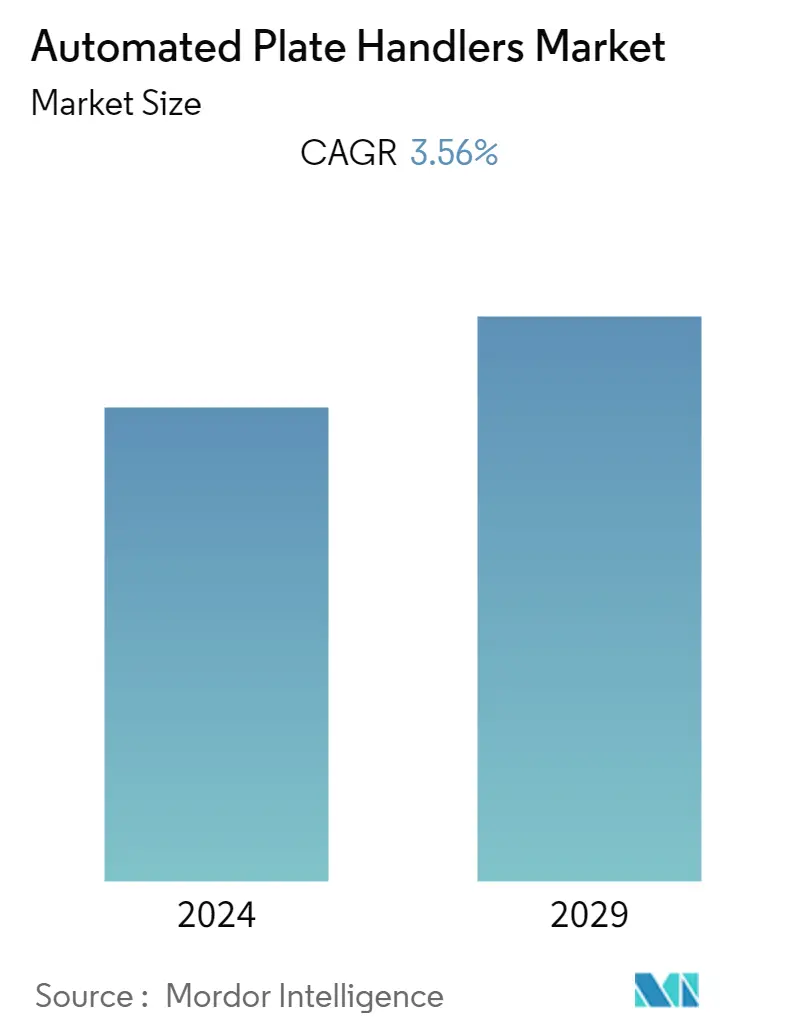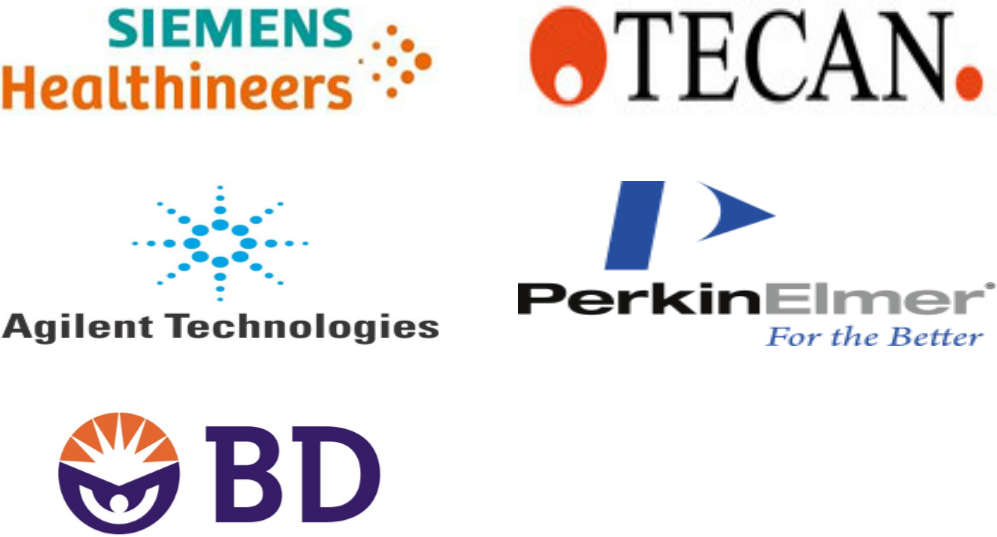Market Size of Automated Plate Handlers Industry

| Study Period | 2019 - 2029 |
| Base Year For Estimation | 2023 |
| Forecast Data Period | 2024 - 2029 |
| CAGR | 3.56 % |
| Fastest Growing Market | Asia Pacific |
| Largest Market | North America |
Major Players
*Disclaimer: Major Players sorted in no particular order |
Automated Plate Handlers Market Analysis
The automated plate handlers market is expected to grow at a CAGR of 3.56% during the forecast period (2020-2025).Research labs and academic institutions are increasinglyopting for modular automation solutions, whereinthey can reduce human intervention in tedious and repetitive tasks.
- Automation is being used widely in various life science applications ranging from drug discoveryto systems biology. Automation is also an important feature in the diagnostics market. In clinical diagnostics, where profits margins are based on the number of samples, high throughput is the most importantfactor which is driving the market studied.
- The drastic increase in sample throughput and the significant decrease in the time to produce experimental results are the major factors driving the automated plate handlers market.
- Moreover, microplate automation instruments are used in laboratories for increased throughput and greater scale in various protocols, such as high throughput screening, next-generation sequencing, cellular analysis, PCR set-up, serial dilution, toxicology, plate labeling, and many more. Apart from reducing the mundane tasks, automated plate handlers market is also driven by the need for consistency in quality as the cost of error is very high in laboratories.
Automated Plate Handlers Industry Segmentation
An automated plate handler is an automated, plate storage and handling system designed for integration with a variety of laboratory devices. The plate handler consists of a high-speed robot, and with its modular design, it provides the flexibility and scalability required to meet the needs of the most diverse laboratory applications.
| By Type | |
| Automated Plate Handler | |
| Automated Plate Stacker | |
| Automated Barcode Labeler | |
| Other Types |
| By End-user Application | |
| Liquid Handling | |
| Drug Discovery | |
| Bio Analysis | |
| Analytical Chemistry | |
| Clinical Diagnostics |
| Geography | |
| North America | |
| Europe | |
| Asia-Pacific | |
| Latin America | |
| Middle East & Africa |
Automated Plate Handlers Market Size Summary
The automated plate handlers market is experiencing significant growth, driven by the increasing adoption of modular automation solutions in research labs and academic institutions. This trend is largely due to the need to minimize human intervention in repetitive tasks, thereby enhancing efficiency and consistency in laboratory processes. Automation is becoming integral in various life science applications, including drug discovery and diagnostics, where high throughput is crucial for profitability. The market is further propelled by the demand for microplate automation instruments, which facilitate increased throughput and scalability in protocols such as high throughput screening and next-generation sequencing. The reduction of mundane tasks and the necessity for quality consistency, given the high cost of errors, are also key factors contributing to market expansion.
In North America, the automated plate handlers market is witnessing rapid growth due to the region's increasing adoption of lab automation, which offers accuracy and ease of use. This shift is reducing human intervention and optimizing throughput time, allowing for more strategic experimental design. The rise in pre-clinical studies and the need for cost-effective sample analysis solutions are fueling market growth in this region. Regulatory support, heightened demand in the diagnostics sector, and the growing focus on drug discovery, alongside the increasing prevalence of diseases like cancer, cardiovascular, and neurological disorders, are further boosting the market. The competitive landscape is characterized by the presence of numerous players, with major companies like Siemens Healthineers AG, Becton Dickinson, Agilent Technologies, and PerkinElmer leading through strategies such as mergers, acquisitions, and product innovation.
Automated Plate Handlers Market Size - Table of Contents
-
1. MARKET DYNAMICS
-
1.1 Market Overview
-
1.2 Introduction to Market Drivers and Restraints
-
1.3 Market Drivers
-
1.3.1 Development of Smaller Automated Machines
-
1.3.2 Increasing Lab Automation
-
-
1.4 Market Restraints
-
1.4.1 Expensive Initial Setup
-
-
1.5 Industry Attractiveness - Porter's Five Force Analysis
-
1.5.1 Threat of New Entrants
-
1.5.2 Bargaining Power of Buyers/Consumers
-
1.5.3 Bargaining Power of Suppliers
-
1.5.4 Threat of Substitute Products
-
1.5.5 Intensity of Competitive Rivalry
-
-
-
2. MARKET SEGMENTATION
-
2.1 By Type
-
2.1.1 Automated Plate Handler
-
2.1.2 Automated Plate Stacker
-
2.1.3 Automated Barcode Labeler
-
2.1.4 Other Types
-
-
2.2 By End-user Application
-
2.2.1 Liquid Handling
-
2.2.2 Drug Discovery
-
2.2.3 Bio Analysis
-
2.2.4 Analytical Chemistry
-
2.2.5 Clinical Diagnostics
-
-
2.3 Geography
-
2.3.1 North America
-
2.3.2 Europe
-
2.3.3 Asia-Pacific
-
2.3.4 Latin America
-
2.3.5 Middle East & Africa
-
-
Automated Plate Handlers Market Size FAQs
What is the current Automated Plate Handlers Market size?
The Automated Plate Handlers Market is projected to register a CAGR of 3.56% during the forecast period (2024-2029)
Who are the key players in Automated Plate Handlers Market?
Siemens Healthineers AG, Becton Dickinson, Agilent Technologies, PerkinElmer and Tecan Group Ltd are the major companies operating in the Automated Plate Handlers Market.

